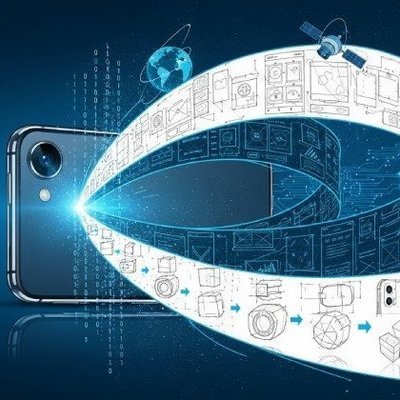When I think about AI and product design, I often go back to a simple, illustrative example: when we first put a camera on a mobile phone. At the time, something like that required a fifty-page document to capture the requirements. Today, I could ask an AI, “We’re adding a camera to a phone—what are the technical considerations?” It would instantly generate a decent draft. That part of the process can be automated now. But what about the idea of putting a camera on a phone in the first place? That spark—that’s human. That’s the boundary I see with current AI. Maybe someday AI can propose those ideas too, but right now, that leap still comes from us.
That’s how I frame the role of AI today. It’s an accelerator. It’s there to help us move faster, especially in the iteration stage. It can help test ideas, refine requirements and explore options—but it’s still up to the human to steer the direction. Creativity, at least for now, remains a human trait.
But “faster” doesn’t mean pumping out more products. It means compressing the cycle from idea to market. There are a lot of iterations in that path—technical constraints, challenges to solve, decisions to make. AI can help with those cycles. It can surface best practices across industries and suggest relevant solutions. You don’t need a hundred people to do that digging anymore—you can get insights quickly and start moving forward.
Editor’s Note: This essay is part of a new series exploring how AI is transforming the way physical products are imagined, designed, and built. Hardware is the New Salt will spotlight several thinkers and makers at the intersection of AI and product design and their insights into this dynamic technology ecosystem. This series is supported by Enzzo, who offers an AI-first product development platform created to support the next generation of builders.
That time savings is powerful. You can bring products to market sooner. But you can also reinvest that time into creativity, stacking more meaningful features before launch. Often, the real inflection point in adoption happens not with a single new feature, but when five or ten come together and create something richer. AI helps us get to that threshold faster.
We’ve seen this pattern before. When GPS was first added to feature phones in the late 2000s, it wasn’t useful immediately. The screens were small, and the apps were limited. It wasn’t until smartphones evolved—bigger screens, integrated maps, real-time navigation—that GPS became indispensable. AI is going through the same early stage. Think about the image generators that used to draw people with six fingers. It takes years of iteration before a tool becomes truly usable. The difference now is that we can iterate faster, so we’ll reach maturity sooner.
But we have to be careful. One of the biggest concerns I see is confidentiality. If you’re feeding proprietary plans into a public AI tool, that information could leak. Some companies are solving this by using private, open-source models hosted on secure servers. But there’s a tradeoff—your model won’t learn from the outside world, so its knowledge is more limited. Still, it’s a safer route for sensitive work.
Adoption of AI will vary by industry. Customer service and fraud detection, for example, will move quickly. They deal with general or anonymized data, and the cost benefits are clear. In areas like product design—where creativity, IP, and long-term strategy are key—companies will be slower and more cautious. And yes, cultural differences play a role. Some companies in Japan still don’t allow employees to access corporate email on their phones. That says a lot.
Despite the challenges, I’m bullish on AI. I’ve always been excited by new technologies and features. I see a lot of potential in how AI can support areas like financial forecasting and portfolio planning. If you have historical data on past product lines, AI can model future revenue, optimize pricing, and suggest launch timing. It’s incredibly helpful, especially at scale. Doing that work by hand is a pain.
And in project management, there’s massive room for improvement. Today, we spend so much time in meetings just gathering updates. Imagine if AI could collect input, highlight delays, and flag risks—that would cut the need for status meetings by half, maybe more. Instead of spending time catching up, teams could spend time solving problems. That’s a real gain.
And so to quote Mr. Andressen, is software still “eating the world”—I think it’s time to remember that software doesn’t run without hardware. Zoom calls –great software, but useless without a computer or a phone. The magic happens at the intersection of the two. That’s where you can really differentiate.
So when I hear the phrase “hardware is the new salt”—I get it. Salt is essential. So is hardware. But I’d argue hardware is even more fundamental than salt. We literally can’t live the lives we lead without it.
About the author:
A twenty-plus year veteran of the wireless industry, Kouji has held a succession of senior product-focused positions, first with Mitsubishi Electric, Sony Ericsson Mobile Communications, HTC and most recently with Motorola Mobility. Kouji led various functions including product planning & management and content & service, leading the efforts to deliver overall product and user experience vision. Kouji was the creator of Moto Z with Moto mods at Motorola, HTC One at HTC, Xperia, Walkman phones and Cybershot phones at Sony Ericsson.
Extensive experience in wireless and consumer market. Specifically, in creating breakthrough products, blending application service, software and hardware into new categories of product, leading or turning around businesses for iconic brands, and leading start-ups. Industry-wide reputation for integrity, home run products, on-time delivery and openness to new ideas and partners.People come 1st. They are central to product, experience and how business is conducted. As a result of forming strong teams, have led numerous landmark products: including 1st music phone (Walkman phone), 1st camera phone (Cyber-shot phone), 1st 4G smartphone, 1st modular phone (Moto Z withMotoMods) and HTC One series.
Recently Kouji have founded i8 Labs, where he utilizes existing smartphone technology & expertise into a new solution to create new innovative business models, as well as commercial activities.i8 Labs is created with an intent to capitalize on a fast growing Smart Sensor market with a mission oftransforming the world to a smarter and more sustainable living. As a co-founder and chief executiveofficer, Kouji is responsible for developing, and driving the vision for i8 Labs and then turning thosevisions into reality. i8 Labs works to solve common City Performance Measurements in the areassuch as Transportation, Environment and Safety by using real time data and analytics.






